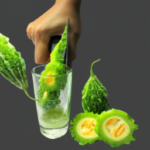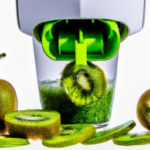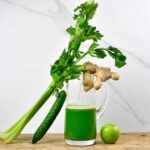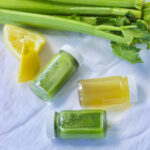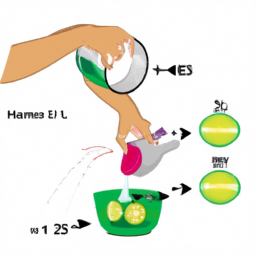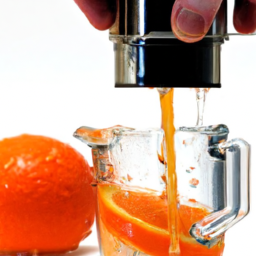Hello! I am excited to share with you my experience in making ash gourd juice. Also known as winter melon and white gourd, this ingredient is commonly used in Asian cuisine and provides many health benefits when juiced. It is a healthy, low-calorie choice that is high in fiber and contains important nutrients like vitamin C, calcium, and potassium.
Before we dive into the recipe, let’s talk about the importance of selecting the right ash gourd. You want to choose a firm, heavy gourd with a smooth and unblemished skin. The skin should be a light green color, and the gourd should feel dense when you hold it.
Once you have your perfect ash gourd, it’s time to start making the juice!
Key Takeaways
- Selecting a ripe ash gourd with the right size is important for quality and quantity.
- Properly preparing ash gourd by cleaning, cutting, peeling, and removing seeds is crucial for taste and increased bioavailability of nutrients.
- Adding additional ingredients such as lemon, mint, ginger, basil, honey, or jaggery can enhance flavor and provide additional health benefits.
- Storing in airtight container in fridge and consuming within 2-3 days maintains freshness and nutritional value.
Selecting the Right Ash Gourd
When it comes to making ash gourd juice, selecting the right ash gourd is crucial. As someone who’s made this juice multiple times, I can tell you that identifying ripe ash gourd and choosing the right size are two key factors to consider.
Ripe ash gourd is usually pale green or white in color, with a hard exterior and a hollow interior filled with seeds. It’s also important to choose an ash gourd that’s not too big or too small, as this can affect the taste and texture of the juice.
Identifying Ripe Ash Gourd
As you search for the perfect ash gourd to make juice, keep an eye out for one that feels heavy for its size and has a smooth, pale green exterior. Here are some tips to help you identify a ripe ash gourd:
- Look for a dull sound when you tap the gourd. If it sounds hollow, it’s not ripe yet.
- Check the stem of the gourd. If it’s dry, it means the gourd is ripe.
- The skin of a ripe ash gourd is hard and can’t be easily pierced with a fingernail.
- Ripe ash gourds have a slightly sweet scent.
Using ripe ash gourd to make juice has many benefits. Ash gourd juice is rich in vitamins and minerals that can help improve digestion, boost immunity, and aid in weight loss. It’s also low in calories, making it a great addition to your diet. So, be sure to select a ripe ash gourd for your juice to reap these nutritional benefits.
When it comes to choosing the right size of ash gourd, there are a few things to keep in mind.
Choosing the Right Size
Picking the perfect size of ash gourd is like finding a golden nugget in a river of pebbles. Size considerations are important because it determines how much juice you can extract from the fruit. A small ash gourd may not yield enough juice while a large one may be too heavy and difficult to handle.
A medium-sized ash gourd is ideal for making juice as it provides a good balance of quantity and quality. Apart from size, health benefits are also a factor to consider when choosing an ash gourd. The fruit is low in calories, high in fiber, and rich in vitamins and minerals. It’s known to have anti-inflammatory properties and may help regulate blood sugar levels.
By choosing the right size of ash gourd, you can reap these health benefits while enjoying a refreshing and nutritious drink. Now, let’s move on to the next step of cleaning and preparing the ash gourd.
Cleaning and Preparing the Ash Gourd
Before making ash gourd juice, it’s important to properly clean and prepare the ash gourd.
First, I usually cut the ash gourd into manageable pieces and peel off the tough outer layer with a knife or vegetable peeler.
Then, I scoop out the seeds and discard them.
These steps ensure that the ash gourd is ready to be used for making juice.
Cutting and Peeling
To easily prepare the ash gourd, start by slicing off the ends and then peeling the skin with a vegetable peeler. It’s important to practice knife safety when handling the gourd, so make sure to use a sharp knife and keep your fingers away from the blade. Additionally, sanitation practices should be followed by washing the gourd thoroughly before cutting.
Once the skin is removed, cut the ash gourd in half lengthwise with a sharp knife. Use a spoon to scoop out the seeds and discard them. This step will ensure that the juice doesn’t have a bitter taste and will also make it easier to blend.
With the seeds removed, the ash gourd is now ready to be cut into smaller pieces for juicing.
Removing the Seeds
Now that we’ve cut and peeled the ash gourd, it’s time to remove the seeds. Seed removal techniques can vary depending on the size and texture of the gourd. For small and tender gourds, you can simply scoop out the seeds using a spoon. However, for larger and tougher gourds, you may need to use a knife to cut around the seeds and then remove them.
It’s important to remove the seeds as they can be bitter and affect the taste of the juice. Aside from improving the taste, removing the seeds from ash gourd also has health benefits. The seeds contain compounds that can interfere with the absorption of nutrients in the body. By removing them, you can increase the bioavailability of the nutrients in the juice.
Additionally, ash gourd seeds have been traditionally used in Ayurvedic medicine to treat various ailments such as diabetes and urinary tract infections. Incorporating the seeds into your juice can provide these added health benefits.
Moving on to the next step, let’s choose additional ingredients to enhance the flavor and nutritional value of the juice.
Choosing Additional Ingredients
One important thing to keep in mind when choosing additional ingredients for ash gourd juice is to make sure they complement the natural sweetness of the ash gourd. This will not only enhance the flavor of the juice but also provide additional health benefits.
Some popular flavor combinations for ash gourd juice include adding mint leaves for a refreshing taste or ginger for a spicy kick. When selecting additional ingredients, it’s important to consider their health benefits as well.
For example, adding lemon juice can help boost your immune system and improve digestion. Alternatively, adding honey can provide antibacterial properties and soothe a sore throat. By choosing the right combination of ingredients, you can create a delicious and nutritious ash gourd juice.
Now that we’ve selected our ingredients, let’s move on to blending the ash gourd juice.
Blending the Ash Gourd Juice
Get ready to blend a delicious concoction that’ll have your taste buds doing a happy dance! Now that you’ve got all the ingredients, it’s time to blend the ash gourd juice.
There are a few blending techniques that can help you achieve the perfect texture for your juice. First, start by blending the ash gourd until it’s smooth and creamy. Then, add in the additional ingredients one at a time, blending in between to ensure that everything is well combined. You can also experiment with different flavor combinations by adjusting the amount of ingredients you add or swapping out one ingredient for another.
Once everything is blended to your liking, it’s time to move on to the next step of straining the juice. Straining the juice will help remove any pulp or seeds that may be left in the mixture. This step is important to achieve a smooth and consistent texture for your juice.
So, grab a strainer or cheesecloth and strain the blended mixture into a clean container. With the juice now strained, it’s time to sit back, relax, and enjoy the delicious and refreshing taste of ash gourd juice!
Straining the Juice
To achieve a smooth and delicious texture for your ash gourd juice, all you need to do is strain the mixture using a strainer or cheesecloth. This process removes any remaining pulp or seeds that may affect the flavor and consistency of your drink.
Here are some tips to improve the flavor and alternative straining methods you can try:
- Use a fine-mesh strainer for a smoother texture and to remove any tiny particles.
- Squeeze the cheesecloth gently to extract as much juice as possible without forcing any pulp or seeds through.
- Add a pinch of salt to enhance the sweetness of the juice.
- Consider using a nut milk bag for a more eco-friendly and reusable alternative to cheesecloth.
By straining your ash gourd juice properly, you can ensure a refreshing and delightful drink that is perfect for any time of the day.
Now that we’ve achieved a smooth and delicious texture, let’s move on to adding finishing touches to make our juice even more special.
Adding Finishing Touches
Now that I’ve strained the ash gourd juice, it’s time to give it some finishing touches.
One way to elevate the drink is by adding garnishes, such as mint leaves or a slice of lemon.
Another important aspect is to make sure the drink is chilled, either by adding ice cubes or refrigerating it beforehand.
These simple additions can make all the difference in creating a refreshing and enjoyable beverage.
Garnishes
Don’t forget to add a slice of lemon or a sprig of mint to your refreshing glass of ash gourd juice for that extra burst of flavor. Not only do these garnish pairings add an aesthetically pleasing touch to your drink, but they also offer their own set of health benefits.
Lemon, for example, is a great source of vitamin C and can help boost your immune system while mint is known for its ability to aid in digestion. To take your ash gourd juice to the next level, consider trying out different garnish pairings such as ginger or basil.
Ginger is known for its anti-inflammatory properties and can help alleviate nausea while basil is a natural stress reliever. Experiment with different combinations to find the perfect garnish pairing for you.
Now that your drink is perfectly garnished, it’s time to move on to the next step: ice and chill.
Ice and Chill
Once you’ve selected your preferred garnish pairing, it’s time to cool down your refreshing ash gourd juice by adding some ice and letting it chill in the fridge for a bit. Adding flavors to your juice is always a good idea, but don’t forget that ice also adds a subtle flavor that can enhance your drink.
You can also opt to use flavored ice cubes, like mint or lemon, to add an extra kick to your juice. Aside from adding flavor, chilling your juice has health benefits too. Cold drinks can help soothe your digestive system and reduce inflammation in your body.
Additionally, cold ash gourd juice can help reduce stress and anxiety, making it the perfect way to unwind after a long day. So, add some ice to your ash gourd juice and enjoy its refreshing taste and health benefits.
Now that your juice is chilled, it’s time to move on to storing it.
Storing the Juice
To keep the freshness intact, seal the bottle of ash gourd juice tightly and store it in the fridge until consumption, like a treasure in a safe. Preservation methods like this are crucial to maintaining the nutritional value of the juice. Moreover, the refrigeration process helps to keep the juice from going bad and developing harmful bacteria.
Here are three tips for storing ash gourd juice to ensure its freshness and quality:
-
Use an airtight container: This will prevent the juice from getting exposed to air and will help keep it fresh for longer.
-
Store it in the fridge: The cool temperature of the fridge will prevent bacteria from growing in the juice and prolong its shelf life.
-
Consume it within 2-3 days: As with any fresh juice, it’s best to consume the ash gourd juice as soon as possible to get the maximum health benefits.
As a result, once you’ve stored the ash gourd juice using these guidelines, you can enjoy the refreshing drink with confidence.
So, let’s move on to the next section to learn about some drinking and serving suggestions.
Drinking and Serving Suggestions
When it comes to drinking and serving ash gourd juice, I find that the time of day plays a big role in how enjoyable it is. I prefer to drink it in the morning because it’s refreshing and helps me start my day on a healthy note.
As for accompaniments, I find that it pairs well with a light breakfast or snacks like nuts and seeds. Overall, ash gourd juice is a great addition to a healthy and balanced diet.
Time of Day
Whether you’re looking for a refreshing morning drink or an evening beverage to wind down, ash gourd juice is a great option. It can be enjoyed at any time of the day, depending on your preference and needs.
Here are some factors to consider when deciding whether to drink ash gourd juice in the morning or evening:
-
Morning vs. Evening: Some people prefer to drink ash gourd juice in the morning as it can help jumpstart their day and provide a burst of energy. Others prefer to drink it in the evening as it can have a calming effect and aid in relaxation.
-
Health Benefits vs. Taste Preference: If you’re drinking ash gourd juice primarily for its health benefits, then it may be best to consume it in the morning when your body is in need of nutrients. On the other hand, if taste is your main concern, then you may prefer to drink it in the evening when you can savor its flavor.
-
Personal Routine: Your daily routine may also dictate when you drink ash gourd juice. If you have a busy morning and need a quick and healthy breakfast, then drinking it in the morning may be the best option. Alternatively, if you have a relaxing evening routine and like to wind down with a drink, then ash gourd juice may be the perfect choice.
-
Climate: The climate can also play a role in when you drink ash gourd juice. In hot and humid climates, drinking it in the morning may be more refreshing, while in cooler weather, you may prefer to drink it in the evening for its warming properties.
Incorporating ash gourd juice into your daily routine is easy and versatile. Whether you drink it in the morning or evening, it can be enjoyed on its own or paired with a number of accompaniments.
Accompaniments
Adding different flavors to your refreshing glass of ash gourd juice can enhance your taste buds and give you a unique experience. If you’re looking for a little extra kick, try pairing your ash gourd juice with mint leaves or ginger.
The mint leaves give a cool and refreshing taste, while ginger adds a spicy kick that complements the mild flavor of the ash gourd. For those who prefer a sweeter taste, adding a small amount of honey or jaggery can do the trick.
But it’s not just about the taste. These accompaniments also offer additional health benefits. Mint leaves are known to aid in digestion and have anti-inflammatory properties, while ginger has been used for centuries to treat nausea and reduce muscle pain. Honey and jaggery are natural sweeteners that also offer antioxidant properties.
So, not only will you be enjoying a delicious drink, but you’ll also be boosting your health at the same time.
Frequently Asked Questions
What are the health benefits of ash gourd juice?
I’ve researched the nutritional composition and health benefits of ash gourd juice. It’s low in calories, high in fiber, and rich in vitamins and minerals. However, excessive consumption may cause potential side effects like diarrhea and abdominal discomfort.
Can I use a different type of gourd for this recipe?
I wondered if I could use a different gourd for juice. After experimenting, I found that bottle gourd and cucumber make good alternatives. However, the taste is different from ash gourd.
How long will the ash gourd juice last in the fridge?
The ash gourd juice can last up to 2-3 days in the fridge if stored properly. Preservation methods include adding lemon juice or storing in an airtight container. A recommended serving size is 1 cup per day.
Can I add sweeteners or other flavorings to the juice?
Yes, adding sweeteners is a personal preference. However, ash gourd juice is naturally low in calories and high in nutrients like vitamin C and antioxidants, making it a healthy choice.
Is ash gourd juice safe for pregnant women and children to consume?
Pregnancy precautions should be taken when consuming ash gourd juice as its safety during pregnancy is not established. Children can safely consume small amounts, but excessive intake may lead to digestive issues.
Conclusion
Wow, making ash gourd juice was much easier than I thought it’d be! The process may seem daunting, but it’s actually quite simple if you follow the steps.
The key to a delicious ash gourd juice is selecting the right gourd, cleaning and preparing it properly, and choosing the right additional ingredients. Once you’ve blended and strained the juice, you can add your own finishing touches and store it for later.
Incorporating ash gourd juice into your diet can have numerous health benefits, including improved digestion and hydration. Plus, it’s a refreshing and tasty way to get your daily dose of nutrients.
So why not give it a try? With a little bit of practice, you’ll be able to make the perfect glass of ash gourd juice in no time!
Ilana has been a vegan for over 10 years. She originally made the switch for health reasons, but soon found herself becoming more and more passionate about the ethical and environmental implications of a vegan lifestyle. Ilana is the author of The Graceful Kitchen, a blog all about veganism. She loves to cook up delicious and nutritious vegan meals, and share her recipes with others who are interested in leading a cruelty-free life. Ilana is also a strong advocate for using whole foods as the foundation of a healthy diet, and believes that going vegan is one of the best ways to achieve this.




